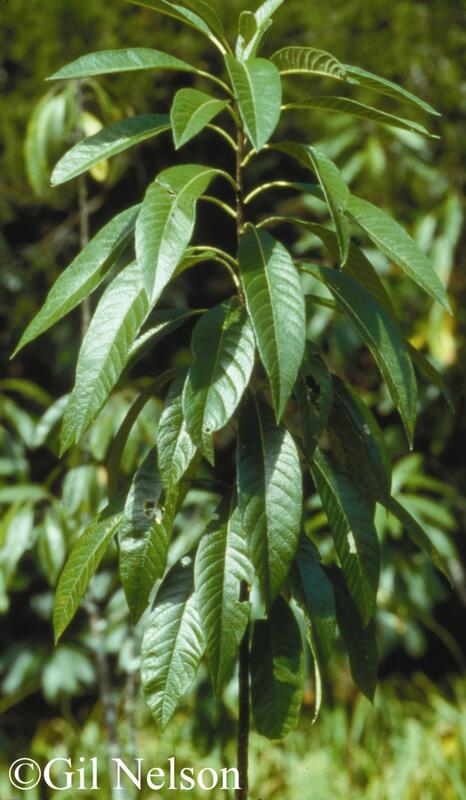







Loading profile. Please wait . . .
Leitneria floridana Chapman
Corkwood




Federal Protection: No US federal protection
State Protection: Threatened
Global Rank: G3
State Rank: S1
Element Locations Tracked in Biotics: Yes
SWAP 2015 Species of Greatest Conservation Need (SGCN): Yes
SWAP 2025 Species of Greatest Conservation Need (SGCN): Yes
2025 SGCN Priority Tier: High Conservation Concern
Element Occurrences (EOs) in Georgia: 15
Habitat Summary for element in Georgia: Swamps; sawgrass-cabbage palmetto marshes
Deciduous shrub or small tree occurring in thickets of many stems connected by rhizomes. Stems are up to 20 feet (6 meters) tall, solitary, unbranched, reddish with many small corky patches (lenticels) and conspicuous leaf scars bearing three bundle scars. Leaves are 2 - 6.7 inches (5 - 17 cm) long and 0.8 - 2 inches (2 - 5 cm) wide, alternate, with entire margins, clustered at and often drooping from the top of the stem; mature leaves are hairless above and hairy beneath, with wrinkled, veiny surfaces. Leaf stalks are 0.8 - 2.8 inches (2 - 7 cm) long. Flowers are very small, borne in erect catkins on last year’s wood before leaves emerge; female and male flowers are usually borne on separate plants (there are rare reports of perfect flowers). Female catkins are 0.4 - 0.8 inch (1 - 2 cm) long, dark red; male catkins are 0.8 - 2 inches (2 - 5 cm) long, yellowish-brown. Fruits are up to 1 inch (1 - 2.5 cm) long, leathery, one-seeded, flat on one side and rounded on the other, yellow turning to brown at maturity, in clusters.
Unbranched saplings of Swamp Bay (Persea palustris) and Tupelo (Nyssa ogechee, N. aquatica) may resemble Corkwood but lack the wrinkled, veiny leaf surfaces. Swamp Bay leaves have a spicy smell when crushed or torn.
None in Georgia. Leitneria floridana was once believed to be the only species in the genus Leitneria and the genus the only member of the family Leitneriaceae. However, recent molecular and morphological research has moved the genus Leitneria into the family Simaroubaceae, and split the one species into two: Leitneria floridana, found in the Coastal Plain of Georgia and Florida, and Leitneria pilosa, found in Arkansas, Missouri, and Texas.
Freshwater or tidal swamps and marshes, especially Sawgrass-Cabbage Palm marshes, river floodplains, and levees.
Corkwood spreads primarily by producing buds on shallow roots, often forming large colonies of genetically identical clones. Corkwood is usually dioecious – its female and male flowers are typically held on separate plants – and its pollen is dispersed by the wind. Because of habitat fragmentation, female and male colonies may become widely separated, thus reducing the chance of sexual reproduction. When fruits are produced, they are probably dispersed by animals. The wood of this shrub is lighter than cork, with a specific gravity of 0.21 (balsa wood has a specific gravity of 0.12); it has been used for fishnet floats and bottle stoppers.
Plants flower February–March, but are identifiable all year by corky reddish bark, leaf scars, and overall wand-like appearance.
If Leitneria is considered to have only a single species, then Leitneria floridana is found in south Georgia, north Florida, east Texas, east Arkansas, and southeast Missouri. The pollen record indicates that Corkwood was once widespread throughout the southeastern U.S. but has persisted in only these few, widely scattered areas.
Ditching, draining, and filling wetlands; alteration of hydrology in streams and rivers. Changes in hydrology due to altered temperature and rainfall patterns related to climate change. Saltwater intrusion into coastal freshwater habitats.
| Threat 1 | Threat 2 | Threat 3 | |
|---|---|---|---|
| General Threat | Biological resource use | Human intrusions & disturbance | Natural system modifications |
| Specific Threat | None | None | None |
Leitneria floridana is ranked S1 by the Georgia Department of Natural Resources, indicating that it is critically imperiled in the state. Thirteen populations have been documented in Georgia, seven on conservation lands, ten of which have been confirmed in the last 10 years.
Protect wetlands from ditching, draining, clearing, and logging. Protect floodplains from changes in stream flow and flooding regimes. Address the problems of climate change and saltwater intrusion.
Chafin, L.G. 2007. Field guide to the rare plants of Georgia. State Botanical Garden of Georgia and University of Georgia Press, Athens.
Channell, R.B. and C.E. Wood, Jr. 1962. The Leitneriaceae in the southeastern United States. Journal of the Arnold Arboretum 43: 435-38. https://www.jstor.org/stable/43781444
Day, J.W. 1975. Autecology of Leitneria floridana. Dissertation, Mississippi State University, Starkville.
Fernando, E.S. and C.J. Quinn. 1995. Picramniaceae, a new family, and a recircumscription of Simaroubaceae. Taxon 44(2): 177-181. https://www.jstor.org/stable/1222440?seq=1#metadata_info_tab_contents
GADNR. 2020. Element occurrence records for Leitneria floridana. Georgia Department of Natural Resources, Wildlife Resources Division, Social Circle, Georgia.
Godfrey, R.K. 1988. Trees, shrubs, and woody vines of northern Florida and adjacent Georgia and Alabama. University of Georgia Press, Athens.
Godfrey, R.K. and A.F. Clewell. 1965. Polygamodioecious Leitneria floridana (Leitneriaceae). Sida 2: 172-173. https://www.jstor.org/stable/41966279?read-now=1&refreqid=excelsior%3A9eec2473bc34a4d645a614ceeb3f6427&seq=1#page_scan_tab_contents
Nelson, G. 1996. Shrubs and woody vines of Florida. Pineapple Press, Sarasota, Florida.
NatureServe. 2019. Leitneria floridana comprehensive report. NatureServe Explorer. Arlington, Virginia. http://explorer.natureserve.org/servlet/NatureServe?searchName=Leitneriafloridana
Schrader, J.A. and W.R. Graves. 2011. Taxonomy of Leitneria (Simaroubaceae) resolved by ISSR, ITS, and morphometric characterization. Castanea 76(3): 313-338. https://www.jstor.org/stable/41301507?seq=1#metadata_info_tab_contents
Sharma, J., J.A. Schrader, and W.R. Graves. 2008. Ecology and phenotypic variation of Leitneria floridana (Leitneriaceae) in disjunct native habitats. Castanea 73(2): 94-105. https://www.jstor.org/stable/20433948?seq=1#metadata_info_tab_contents
Sharma, J. and W.R. Graves. 2004. Germination of Leitneria floridana seeds from disjunct populations. HortScience 39: 1695-1699. https://scholars.ttu.edu/en/publications/germination-of-leitneria-floridana-seeds-from-disjunct-population
Weakley, A.S. 2015. Flora of the southern and mid-Atlantic States. University of North Carolina Herbarium, University of North Carolina, Chapel Hill. http://www.herbarium.unc.edu/flora.htm
Linda G. Chafin
L. Chafin, Sep. 2007: original account
K. Owers, Feb. 2010: added pictures
L. Chafin, Mar. 2020: updated original account.



